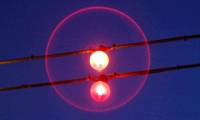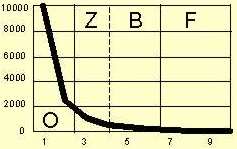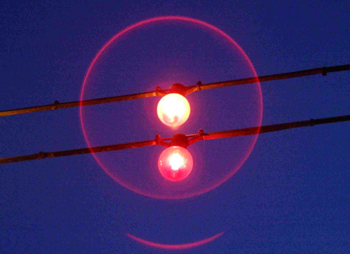Orb Zone - mists and twists

The ‘orb zone’

Mist (ectoplasm?) created by photographing steam in the ‘orb zone’
Digital cameras have lenses with a much greater depth of field than film cameras. This means that the nearest point to the camera that is in focus is a lot closer. It also brings the ‘just out of focus’ area (‘orb zone’) closer as well. The ‘orb zone’ is so close that it is intensely illuminated by the flash. The intensity of the flash increases according to an inverse square law with decreasing distance. Indeed, if the subject of your photograph is at a distance of 5m, a particle of dust at 5cm from the camera receives approximately 10,000 times greater light intensity! This creates an ‘orb zone’ in digital cameras where the light intensity is sufficient to illuminate the faint out-of-focus bits of dust, which appear as circles of confusion (or ‘orbs’).

Graph showing orb zone
The graph shows flash illumination diminishing with distance (to right).
O = too out of focus to be visible even with flash
Z = (orb zone) out of focus but visible due to high flash intensity
B = out of focus but invisible because flash not intense enough
F = in focus and visible
In a film camera, all the zones move further out and the ‘orb zone’ generally vanishes because there is insufficient flash intensity at the increased distance.
As digital cameras get larger CCDs (not just megapixels but physically), their lenses get decreasing depth of field. This means that the problems of orbs and strange mists should gradually vanish. No more spoiled pictures!

Beautiful example of lens flare
Mists
Mists (some people think they resemble ectoplasm) are common on anomalous photographs. Such mists have, like orbs, become much more common since the advent of digital cameras. Like orbs, their cause is not usually noticed at the time the photograph is taken. Many such photos are taken in allegedly haunted places.
The origin of the mists is probably mostly the photographer’s breath on a cold night. It is generally night because the mists need a dark background to show up well (and not be seen by the photographer) and cold for obvious reasons. A small number of cases may be caused by the photographer smoking and then forgetting about it!
The reason why the mists are on the photo but not seen at the time is that they are in the ‘orb zone’, where the flash produces intense, if brief, illumination.

Spiral (vortex?) using camera strap
Lens flare
Another common cause of strange fuzzy ‘objects’ in photos is lens flare. See the photo on the home page for an example (look at the line of bright elliptical shapes descending from the sky). It is caused by a bright light source, just outside the field of view, causing reflections inside the camera. Flare usually appears as regular geometric shapes though it can appear as amorphous mists. The common variety is ‘aperture ghosting’ though there are other types. It is also possible to get flare with strong light sources (particularly against a dark background) within the picture frame. There is a beautiful example of this in the picture at the bottom left of this page. The flare here appears as a ring around the light source with partial secondary ring. Much more of flare here.
Orbs with film cameras
As orbs are essentially to do with the depth of field of a lens, there is no reason why they shouldn’t occur with film cameras. Any camera with a low depth of field lens (eg wide-angle lens) and a flash close to the lens may be have an orb zone.
Spirals (vortexes)
In Anomaly 18 (1996), John and Anne Spencer demonstrated how mysterious fuzzy white spirals of light, often seen on anomalous photographs, were, in fact, camera straps! Accidentally left very close in front of the camera lens, the straps appeared as white spiral ‘shafts of light’ when illuminated by the camera flash.
Spirals (or vortices) should be less of a problem these days. That is because digital cameras show the the photographer what the camera is seeing with a LCD screen on the back. However, not everyone uses these screens to frame their pictures. Many still use a viewfinder that cannot see what is directly in front of the main camera lens.
One puzzle is why the camera straps so frequently appear as tight spirals (resembling, to some, a vortex). In fact, it is an illusion. The ‘spirals’ are, in fact, produced by the ribbed structure of the camera strap (photo left). Combine the ghostly white appearance produced by the flash, the fuzzy edges and the shadow (also caused by the flash) giving a dark line down the edge and you have a spiral or vortex.
Not all mysterious fuzzy white objects show up as a spiral or vortex. That’s because they’re produced by other objects accidentally left in front of the camera lens. Typical objects include fingers, hair and camera cases.
Sometimes you can get fuzzy dark, shadowy objects (and even other colours) in your photos. These are also usually caused by objects left unintentionally in front of the lens. The difference is that no flash was used to take the photo. If they are very close to the lens they will appear dark and shadowy. Further away they may be light enough to appear coloured.
Expert help
If you get a strange photo, who should you consult? Well, there’s us, of course, but failing that try a real expert in photography (or even a camera manufacturer). The most accessible (and often extremely well-informed) experts are keen amateur photographers.
There are good websites to consult as well. Look for technical photography sites. Try Wrotniak’s superb photography website for excellent technical information.